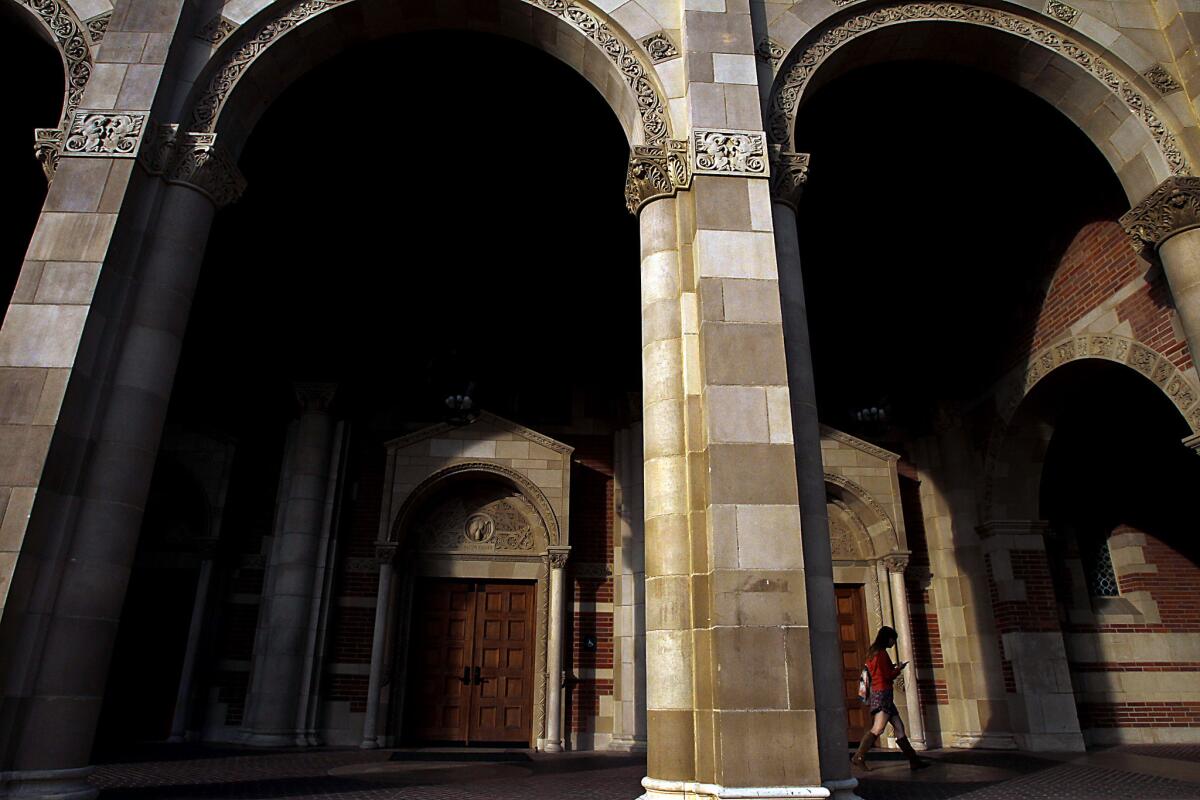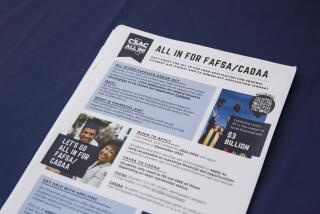How a security upgrade makes it harder to apply for financial aid this year

A student at UCLA’s Royce Hall.
- Share via
Many low-income students and children of undocumented parents are having a harder time finishing their financial aid applications this year. That’s because of a new system that’s meant to protect sensitive financial information but in practice keeps out already-disadvantaged populations.
Californians must submit the Free Application for Federal Student Aid (FAFSA) by midnight Wednesday to be eligible for the biggest pot of state college funds, the Cal Grant. Officials are asking students to submit even an incomplete FAFSA immediately, so that they make the deadline but can fill in more information later.
The change has plunged college counselors across the state — and country — into overdrive as they spend more time handling digital paperwork.
The new security system requires parents and students to create an “FSA ID.” It feels so impenetrable that it has led some advocates, such as Kim Cook, director of the National College Access Network, to wonder whether it went slightly overboard.
To create an FSA ID, one must have an email address — but counselors say that the parents of low-income students are less likely to have one.
You also need to have a Social Security number, which edges out students whose parents are undocumented immigrants. And password recovery is also tricky — when you create a password, you have to answer three personal “challenge questions,” create your own question and answer it, and enter “a significant date” that’s not your birthday.
In other words, it’s a lot for a high school student to remember.
Any hindrance in applying for financial aid can keep them from getting to college, because it would be nearly impossible for many to afford it.
Across the country, borrowers who graduated in 2014 had an average student debt of $28,950, compared to $21,382 in California. Compared to other states, California is relatively generous in its financial aid offerings: for students who demonstrate financial need and have a GPA of 3.0 or higher, the Cal Grant pays for different types of schooling, including nearly a full ride at University of California schools; for different GPAs, there are different awards. But that means little if eligible students can’t get the cash.
“The reason why low-income kids don’t go to college is a fear that they can’t pay for college,” said Marie Groark, director of Get Schooled, an organization that runs a texting hotline that helps students get to college. “Because of barriers like this, if they can’t get their FAFSAs done, kids cannot go to college because they cannot pay for college.”
It’s possible to file for financial aid without creating an ID, by mailing in an application, but that takes longer. “Since students have to mail the signature page it takes longer for the student’s FAFSA to be processed,” said Carlos Benitez, a counselor at Gertz-Ressler High School in Los Angeles. “Signature pages have been taking longer to process.” It’s also possible to mail in an application for a student whose parent who doesn’t have a Social Security number.
Get Schooled surveyed its members in 34 states and found that of the 220 students who responded, 22% of students across the country and 21% of those in California said they had some issues with FSA ID.
“I am just so confused about FSA ID,” one student texted. “I could set not up a FSA ID, I got so many error messages so I had to mail it,” said another one.
Lynda McGee, a counselor at Downtown Magnets High School in Los Angeles, which has a high population of poor students, has processed 200 FAFSAs so far. This year is tough, she said. It often “says the Social doesn’t match, we can’t even get the ID,” she said. “For students like mine, without the Cal Grant, they probably would not be attending a UC.”
Join the conversation on Facebook >>
Counselors in different places told the College Access Network that it has taken almost double the time to complete a FAFSA as it has in previous years, Cook said. “Any extra hoop that we ask a student to go through is telling us that it’s hurting … FAFSA completion,” Cook said. She asserts that on balance, the new ID is a good thing, because students are submitting IRS data online, but added that it should become more user-friendly.
And it’s a potential barrier not only for high school seniors, but for adults who need to renew their applications or are eligible for a different kind of financial aid. This year, Sophia Faruqi, a student at Solano Community College in Fairfield, became eligible to receive the more generous Cal Grant as opposed to federal grants. But when applying, she got locked out for a day.
She ultimately succeeded, but the process was stressful. “I was like, ‘oh my God, how am I going to pay for that?’” she said.
To help solve the problem, schools across California have held “Cash for College” events to get the word out. In Fresno, 1,200 people came to a similar event, according to Ruben Castillo, the administrator of migrant education for the Fresno County Office of education. At Gertz-Ressler High School in Los Angeles, parents and students were given homework two weeks in advance: create an FSA ID.
Castillo and others worry that the glitch is causing fewer students to complete financial aid applications, but it’s hard to be certain. State officials said they thought based on available information, seniors were on track to complete FAFSAs at the rate they expected. But according to an analysis from Troy Miller, associate director for research and policy at the Florida College Access Network, FAFSA completions for California’s 12th-graders are down 10.9% between Feb. 19 of 2015 and 2016.
That drop, though, could be caused by several factors: the size of the senior class, the number of seniors graduating or going to college, or problems with the form itself. Miller observed similar trends across several states.
The federal government, Miller said, is mining their data for an answer.
As of Thursday, about 28 million users created an FSA ID since its launch, said Dorie Nolt, a U.S. Department of Education spokeswoman.
“Cybersecurity has changed significantly since 1998, so it was critical that we updated the security measures,” she said in a statement. “As with any new online log-in system, we know there will be users who have difficulty, and we encourage them to call 1-800-4-FED-AID (1-800-433-3243) or visit StudentAid.gov/fsaid for assistance.”
“I am very concerned that the number of kids who are not accessing the application is because they don’t know how to maneuver and manipulate the system,” Castillo said. “For a lot of these kids, this is the only way they can attend higher education. They get left out.” Castillo is working with a nonprofit to sponsor legislation that would make the creation of an FSA ID number a graduation requirement.
A spokesperson from the Los Angeles Unified School District, though, said its director of academic and counseling services reported that the district had not received calls about the ID.
Lupita Cortez Alcalá, executive director of the California Student Aid Commission, hopes that all students will at least submit a FAFSA before the deadline, even if not all their information is filled in — they can then complete their application. She added that CSAC, the state’s financial aid agency, has customer service representatives available from 7 a.m. until 6 p.m.
As the moments before the midnight deadline tick away, school counselors reflect on the significance behind the glitches. “Certain populations with wealthier student bodies, they’ve got kids working with private counselors and they get it done. Or they have parents who are very savvy,” McGee said. “A lot of my kids depend on me.”
McGee noticed that wealthier kids just know they’re going to college. They don’t question that it’s coming to them. “Sometimes, when you’re dealing with first-generation kids, they tend to wonder if they deserve it,” she said. “It’s hard to teach entitlement.”
You can reach Joy Resmovits on Twitter @Joy_Resmovits and by email at [email protected].
ALSO
New L.A. schools chief Michelle King calls for making peace with charters
Thanks to Nike’s Phil Knight, Stanford is planning an ambitious graduate scholars program
Why only 19% of Cal State freshmen graduate on time -- and what lawmakers aim to do about it
More to Read
Sign up for Essential California
The most important California stories and recommendations in your inbox every morning.
You may occasionally receive promotional content from the Los Angeles Times.











